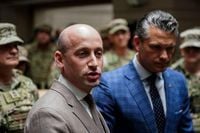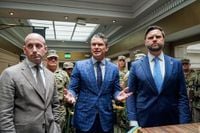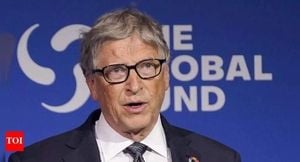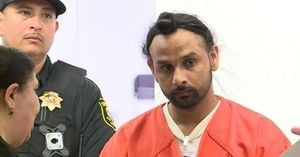As the summer heat lingers over Washington, DC, the city finds itself at the center of a fierce national debate over crime, policing, and political power. President Donald Trump’s recent decision to federalize the Metropolitan Police Department and deploy nearly 2,000 federal officers and National Guard troops into the capital has produced both dramatic changes on the ground and a storm of political and public reaction.
On August 11, 2025, President Trump signed an executive order declaring a crime emergency in Washington, DC. Within days, the city saw a surge of uniformed and armored personnel, with more than half of the 1,900 troops coming from Republican-led states, according to the Associated Press. The government’s stated aim: to restore order amid what it described as a crisis of lawlessness and violence.
Vice President JD Vance has emerged as one of the administration’s most vocal defenders of the crackdown. In a Fox News interview on August 20, Vance touted what he called remarkable results: “Violent crime has dropped in DC, 35% in nine days and robberies in DC have dropped 55% in nine days.” He argued that political will, not just policy, is what makes the difference. “If you’ve got the political will to enforce the law, you can make even cities like DC safe again, and that’s what we’re demonstrating,” Vance said, according to Fox News.
The vice president’s remarks were part of a broader critique of Democratic leaders, particularly California Governor Gavin Newsom, whom Vance accused of inauthentically mimicking Trump’s political style. “You’ve got to be yourself. You’ve got, actually, to talk to people honestly about the issues,” Vance said on Fox News. “Gavin Newsom can mimic Donald Trump all that he wants to, they’re still going to lose unless they get better policies that actually serve the American people.”
But the federal show of force has not gone unchallenged. On August 20, Vance and Defense Secretary Pete Hegseth visited National Guard troops at Union Station, the city’s main train hub, while protesters outside chanted “free D.C.” The scene was emblematic of the city’s tense mood. “We brought some law and order back,” Vance asserted, handing out burgers to troops. Yet, as the Associated Press reported, the presence of armored vehicles and heavily armed personnel has unsettled many residents, who see it as an occupation rather than a rescue.
The friction between the federal government and city leadership is palpable. Mayor Muriel Bowser, facing the daunting task of balancing public safety and democratic self-determination, acknowledged the “changing situation” as schools prepared to reopen. “This is not the same time, is it, that we experienced in opening school last year,” she told teachers and staff, according to the Associated Press. Bowser urged educators to focus on their students’ well-being, emphasizing the need for children to “have joy when they approach this school year,” even as armored vehicles and troops patrolled their neighborhoods.
The militarized backdrop has already led to unintended consequences. Early on August 20, an armored vehicle collided with a civilian car less than a mile from the U.S. Capitol, trapping one person and sending them to the hospital with minor injuries. The cause of the accident remains unclear, but the incident quickly became a flashpoint for critics of the federal intervention. “You come to our city and this is what you do? Seriously?” a bystander shouted at the troops, as captured in a video posted online.
Attorney General Pam Bondi announced that more than 550 people had been arrested since the crackdown began, with U.S. Marshals offering $500 rewards for information leading to further arrests. “Together, we will make DC safe again!” Bondi proclaimed on social media. Yet, for many residents, the heavy-handed approach has only deepened distrust between law enforcement and the community.
Prominent criminologists have sounded the alarm about the long-term consequences of such tactics. Elliot Currie, a professor at the University of California, Irvine, called Trump’s federal takeover “counterproductive” and a symptom of “creeping authoritarianism.” In an interview with Mother Jones, Currie warned, “This is not going to work out well down the road. They’re sowing some bad seeds here—almost as if they’re trying to do it.” He argued that reducing violent crime requires more than a show of force; it demands trust, community investment, and a focus on solving crimes, not just arresting people. In 2024, DC’s homicide clearance rate was a modest 60%, only slightly above the national average.
Currie and other critics point out that the Trump administration’s actions may actually undermine public safety. In April 2025, the White House canceled nearly 400 grants worth over $800 million from the Department of Justice’s Office of Justice Programs, including more than $500,000 for violence prevention initiatives in DC. “By starving communities of the violence prevention, behavioral health services, and other investments that young people in particular need to flourish, we’re priming ourselves for another spike in crime,” Currie said.
The crackdown has also revived debates over policing tactics. Trump’s decision to pardon two MPD officers involved in a deadly 2020 chase—and to reinstate them with back pay—sparked outrage among reform advocates. The officers had been convicted of second-degree murder and obstruction of justice, but Trump characterized their actions as heroic, despite the victim, Karon Hylton-Brown, being a DC native.
While some residents acknowledge frustration with ongoing crime—such as reckless ATV riders and porch pirates—many worry that the militarized response will make things worse. Reports have surfaced of federal officers pursuing suspects in high-speed chases through residential streets, risking bystanders’ safety. Others question the effectiveness of arresting people for minor infractions, like fare evasion, which is a civil offense in DC, not a crime.
Despite the administration’s claims of quick results, questions remain about whether the crackdown is targeting the neighborhoods most affected by violence. According to Mother Jones, federal agents have been less visible in high-crime areas like Ward 8, while shootings there continue. Yet, the White House touts hundreds of arrests and insists the strategy is working.
The national conversation has even spilled into pop culture. South Park, known for its sharp satire, released a promo lampooning the federal crackdown, with its towel character observing troops and tanks in front of the White House. The show’s creators, Trey Parker and Matt Stone, recently signed a $1.5 billion deal for new episodes and streaming rights, ensuring that the DC saga will remain fodder for late-night laughs.
As public schools reopen and residents adjust to the new reality, the city remains divided. Supporters of the crackdown argue that bold action was needed to stem rising violence, while critics see it as an overreach that threatens civil liberties and community trust. The only certainty is that Washington, DC, is now a battleground—not just over crime, but over the very meaning of democracy and public safety in America’s capital.
For those living and working in DC, the coming weeks will reveal whether the federal intervention brings lasting peace or leaves deeper wounds in a city already grappling with complex challenges.





